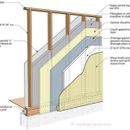EIFS and total R-values
Considering EIFS on a new house in zone 4/5, and I have a question about the effect the ventilated drainage gap has on the R-Value, since it’s behind the EPS. Does that exposed gap introduce cold air and compromise the R-value provided by the EPS, or is the effect insignificant?
The closest info I could find was from BSC:
“Installed insulation R-value: The framed portion of this wall assembly typically has an R-value of R-19-20 when insulated with fiberglass batt or cellulose. Exterior insulation for EIFS is typically EPS at R-4/inch.
Whole-wall R-value: Using two-dimensional heat flow analysis with thermal bridging effects and average framing factors demonstrates improvements in the efficiency of the fiberglass batt or cellulose in the stud space by decreasing the thermal bridging effects of the framing and the rim joist. Adding 4” of EPS insulation for a total increase of R-16 increases the clear-wall R-value of standard construction by slightly more than R-16 because of thermal bridging of the framing and rim joist. The whole-wall R-value for this system is approximately R-30.”
Should I just take that whole-wall R-value estimate as gospel?
Second question: Is there a minimum EPS thickness for an EIFS wall in Zone 4/5?
GBA Detail Library
A collection of one thousand construction details organized by climate and house part










Replies
Tim,
Q. "Does that exposed gap introduce cold air and compromise the R-value provided by the EPS, or is the effect insignificant?"
A. Your question is answered by Joe Lstiburek in his article, Mind the Gap, Eh! In the article, Lstiburek writes, "Won’t the tiny gap cause a loss of thermal performance of the foam sheathing? Yes. How much? About 5 percent of the thermal performance of the foam sheathing (not the entire wall assembly) with the 1/8-inch gap, less with a smaller gap. With “crinkly” stuff you loose next to nothing.7 Is it worth it? Yes, in my opinion, the loss in thermal performance is trivial compared to the reduced risk and improved durability."
It's well worth reading all of Lstiburek's article, by the way.
Tim,
Q. "Is there a minimum EPS thickness for an EIFS wall in Zone 4/5?"
A. There are two requirements here: (1) Your wall assembly must meet minimum code requirements for total R-value. (2) If you choose to install exterior rigid foam, you need to follow the guidelines for minimum foam thickness summarized in this article: Calculating the Minimum Thickness of Rigid Foam Sheathing.
So, we need you to answer three questions:
1. Are you planning to frame your walls with 2x4s or 2x6s?
2. Will you install any insulation between your studs?
3. If you install insulation between your studs, what type of insulation will you choose?
Thanks Martin, that quote from "Mind the Gap, Eh!" was exactly what I was looking for.
As for the minimum EPS, yes that article is what I was referring to b/c you say, "Thin foam is dangerous, because it reduces the ability of the wall to dry to the exterior without warming the sheathing enough to prevent moisture accumulation (a phenomenon that is usually but incorrectly called “condensation”)."
Since there's a drainage gap between the sheathing and EPS, does this moisture accumulation still present a problem? I plan to use 2" of EPS and a 2x6 wall with spider insulation. Any issues there?
Tim,
If you want to install exterior rigid foam on a 2x6 wall in Climate Zone 5, the rigid foam needs to have a minimum R-value of R-7.5. Two inches of EPS has an R-value of R-8, so your wall is OK.
Deleted
Martin,
I read Lstiburek's article, it is just what I wanted to know, Thanks! In the article, he routinely mentions creating a 3/8" drainage plane , but mentions 1/8" when discussing EIFS. Would 3/8" gap created by something like Ben Obdyke City Slicker be better and what would be the impact to the overall R value of the EIFS system?